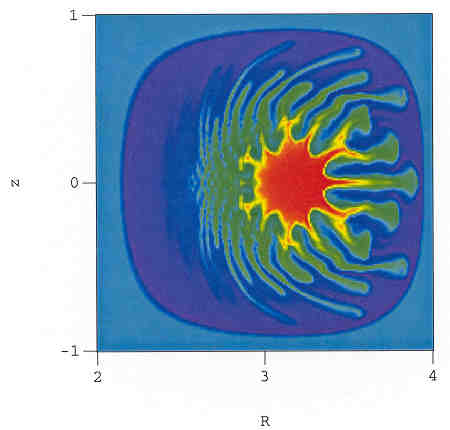b Limit Disruptions in Tokamaks
Kleva, Guzdar
The most serious impediment to the practical utilization of tokamaks
as fusion reactors is the limitation on the plasma thermal pressure
imposed by disruptions. The ratio b of the thermal pressure to
the pressure of the confining magnetic field provides a measure of the
efficiency of a magnetic confinement fusion reactor. Operation at high
b is very desirable because it yields a large fusion reaction
rate relative to the cost of the confining magnetic field. However,
experimental attempts to increase the ratio b beyond a critical
limit bc have been thwarted by an abrupt, catastrophic loss of
confinement. Not only do these disruptions limit b and,
therefore, limit the efficiency of a tokamak, but the disruptions
themselves can cause serious damage to the reactor. Displayed below are results from 3D MHD simulations performed on the T3E machine at NERSC.

The figure above shows three-dimensional isosurfaces of the pressure as the instability develops along ridges dominantly aligned along the ambient magnetic field.

The figure on the right is a poloidal projection of the pressure that shows the hot plasma fingers as they reach the wall. Our nonlinear simulations of tokamak stability reproduce the salient
features of the disruptive loss of confinement. High b toroidal
equilibria are linearly unstable to ballooning modes that grow on the
pressure gradient on the large R side of the magnetic axis, where
R is the major radius of the torus. The convection cells associated
with the unstable ballooning modes transport the thermal energy toward
the wall at large R in hot plasma ridges whose two-dimensional
projection in the poloidal plane resembles fingers. As the hot central
plasma is transported out in R in fingers, the average pressure
gradient is reduced so that it no longer completely balances the
Lorentz force of the confining magnetic field. As a result, there is a
small net inward force in R caused by the unbalanced Lorentz
force. At lower bthis force generates an axisymmetric flow
that opposes the growth of the fingers to the wall at large R,
thereby stabilizing the plasma nonlinearly and maintaining
confinement. However, as b increases the growth rate of the
plasma fingers towards the wall becomes so rapid that there is
insufficient time for the self-consistently generated axisymmetric
flow to halt their progress before they strike the wall, and
confinement is lost.
Recent papers dealing with disruptions in tokamaks:
This research is supported by the U.S. Department of Energy.


